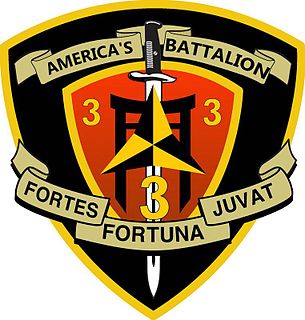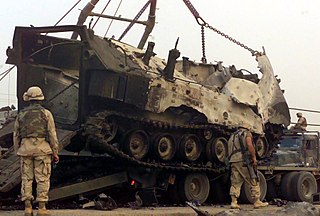
The First Battle of Fallujah, code-named Operation Vigilant Resolve, was an operation against militants in Fallujah as well as an attempt to apprehend or kill the perpetrators of the killing of four U.S. contractors in March 2004.

The Second Battle of Fallujah—code-named Operation Al-Fajr and Operation Phantom Fury—was a joint American, Iraqi-government, and British offensive in November and December 2004, the highest point of conflict during the Iraq War. It was led by the U.S. Marines against the Iraqi insurgents in the city of Fallujah, and was authorized by the U.S.-appointed Iraqi Interim Government. The U.S. military called it "some of the heaviest urban combat U.S. Marines have been involved in since the Battle of Huế City in Vietnam in 1968."

The Battle of Khafji was the first major ground engagement of the Gulf War. It took place in and around the Saudi Arabian city of Khafji, from 29 January to 1 February 1991 and marked the culmination of the Coalition's air campaign over Kuwait and Iraq, which had begun on 17 January 1991.

The 4th Marine Division is a reserve division in the United States Marine Corps. It was raised in 1943 for service during World War II, and subsequently fought in the Pacific against the Japanese. Deactivated after the war, the division was re-formed in 1966 and elements of the division deployed during the Gulf War in 1990–1991, as well as during the Iraq War. It is currently the ground combat element of the Marine Forces Reserve and is headquartered in New Orleans, Louisiana and has units throughout the United States.

The 5th Marine Regiment is an infantry regiment of the United States Marine Corps based at Marine Corps Base Camp Pendleton, California. It is the most highly decorated regiment in the Marine Corps and falls under the command of the 1st Marine Division and the I Marine Expeditionary Force.

The Battle of Abu Ghraib was a battle between Iraqi insurgents and United States forces at Abu Ghraib prison on April 2, 2005.

1st Light Armored Reconnaissance Battalion is a fast and mobilized armored terrestrial reconnaissance battalion of the United States Marine Corps. Nicknamed the "Highlanders," their primary weapon system is the LAV-25 Light Armored Vehicle armed with the M242 25mm Bushmaster chain gun. They fall under the command of the 1st Marine Division and the I Marine Expeditionary Force. The unit is based out of the Marine Corps Base Camp Pendleton, California.

1st Battalion 1st Marines is an infantry battalion in the United States Marine Corps based out of Camp Pendleton, California, consisting of anywhere from 800 to 2,000 Marines and Sailors, but the number fluctuates depending on the Battalion's mission. They fall under the command of the 1st Marine Regiment and the 1st Marine Division. Commonly referred to as "The first of the First."

2nd Light Armored Reconnaissance Battalion is a fast and mobilized armored terrestrial reconnaissance battalion of the United States Marine Corps. Their primary weapon system is the 8-wheeled LAV-25 and they fall under the command of the 2nd Marine Division and II Marine Expeditionary Force. The unit is based out of the Marine Corps Base Camp Lejeune, North Carolina. The current mission statement of the battalion is: To perform combined arms reconnaissance and security missions in support of the Ground Combat Element (GCE) of a Marine Air-Ground Task Force (MAGTF). Its mission is to conduct reconnaissance, security and economy of force operations, and, within its capabilities, limited offensive or defensive operations that exploit the unit's mobility and firepower.

3rd Light Armored Reconnaissance Battalion(3D LAR BN) is a fast and mobilized armored terrestrial reconnaissance battalion of the United States Marine Corps. Their primary weapon system is the LAV-25 and they are part of the 1st Marine Division and I Marine Expeditionary Force. The unit is based out of the Marine Corps Air Ground Combat Center Twentynine Palms, California.

The 3rd Reconnaissance Battalion conducts amphibious and ground reconnaissance in support of the 3rd Marine Division and Marine Forces Pacific (MarForPac), operating in the commander's areas of influence. The Battalion is based out of Camp Schwab, a satellite base of Marine Corps Base Camp Smedley D. Butler. It is geographically located on the Okinawa Prefecture in Japan.

3rd Battalion, 3rd Marines, abbreviated as (3/3), is an infantry battalion of the United States Marine Corps, based out of Kāne'ohe, Hawai'i. Known as either "Trinity" or "America's Battalion", the unit falls under the command of the 3rd Marine Regiment of the 3rd Marine Division. The unit consists of approximately 1124 U.S. Marines and United States Navy sailors.

3rd Battalion, 23rd Marine Regiment (3/23) is a reserve infantry battalion in the United States Marine Corps located throughout the Midwestern United States consisting of approximately 800 Marines and Sailors. The battalion was first formed in 1943 for service in the Pacific Theater of Operations during World War II, taking part in a number of significant battles including those at Saipan and Iwo Jima before being deactivated at the end of the war. In the early 1960s, the unit was reactivated as a reserve battalion. The battalion is headquartered in Saint Louis, Missouri, with outlying units throughout the Midwestern United States. 3/23 falls under the command of the 23rd Marine Regiment and the 4th Marine Division. Recent operations have included tours in Iraq and Afghanistan.

3rd Battalion, 24th Marines (3/24) was a reserve infantry battalion in the United States Marine Corps. The battalion was first formed in 1943 for service in the Pacific Theater of Operations during World War II, taking part in a number of significant battles including those at Saipan and Iwo Jima before being deactivated at the end of the war. In the early 1960s, the unit was reactivated as a reserve battalion. It was located throughout the Midwestern United States and consisted of approximately 800 Marines and Sailors. The battalion was part of the 24th Marine Regiment and the 4th Marine Division. Recent operations included tours in Iraq and Afghanistan. On May 19, 2013, the battalion was deactivated (retired) as a part of 2013 Marine Corps Force Restructuring, along with the 24th Marine Regiment. 3/24 personnel were reallocated to 23rd Marine Regiment, with the majority of the companies becoming 3rd Battalion, 23rd Marines.

4th Assault Amphibian Battalion is a mechanized battalion of the United States Marine Corps reserve. Their primary weapon system is the AAV-P7/A1 Amphibious Assault Vehicle and they are part of the 4th Marine Division of the Marine Forces Reserve. The unit is based out of Tampa, Florida, with subordinate units in Florida, Virginia and Texas.

The Battle of Nasiriyah was fought between the US 2nd Marine Expeditionary Brigade and Iraqi forces from 23 March to 2 April 2003 during the US-led invasion of Iraq. Nasiriyah is a city which lies along the banks of the Euphrates River in Dhi Qar Province, about 225 mi (362 km) southeast of Baghdad. Its population is made up almost entirely of Shia Muslims. On the night of 24–25 March, the bulk of the Marines of Regimental Combat Team 1 passed through the city over the bridges and attacked north towards Baghdad. However fighting continued in the city until 1 April when Iraqi resistance in the city was defeated.
The Battle of Husybah was fought in the spring of 2004 at the same time as the First Battle of Fallujah. In April 2004, Fallujah was under siege by United States Marines, and insurgents were looking to relieve pressure on the city by attempting an offensive of their own. Ten days before, the highway connecting Al Anbar to Baghdad was cut and the insurgents attacked the capital of the province, Ramadi. The attack was repulsed by the Marines and the battle resulted in heavy casualties on both sides. Now the insurgents were ready for another attack which would serve as third location attacked in a simultaneous assault against U.S. forces, on the city of Husaybah on the Syrian border. Infantry elements of 3rd Battalion, 7th Marine Regiment Lima Company, 2 platoons from Kilo Company and CAAT White, were deployed to Husaybah to counter the enemy offensive.
Al-Karmah, also sometimes transliterated as Karma, Karmah, or Garma, is a city in central Iraq, 16 km (10 mi) northeast of Fallujah in the province of Al Anbar.

Justin D. LeHew is a United States Marine who served in the War on Terror. He was awarded the Navy Cross for his actions on 23 and 24 March 2003 during the initial 2003 invasion of Iraq. He was hand picked to spearhead the rescue operation and recovery of the U.S. Army's 507th Maintenance Company on 23 March and subsequently was called upon again to take part in the rescue operation of US Army Private Jessica Lynch on 1 April 2003. He is also a recipient of the Bronze Star with Combat Distinguishing Device denoting Valor for his heroic actions from 5 to August 28, 2004 during the Battle of Najaf.

Camp Leatherneck was a 1,600 acre United States Marine Corps base in Helmand Province, Afghanistan. The site was mostly in Washir District and was conjoined with Camp Bastion, which was the main British military base in Afghanistan and Camp Shorabak which initially was the main Afghan section however the three sites were joined together under the name of 'Camp Shorabak' in 2014.


















